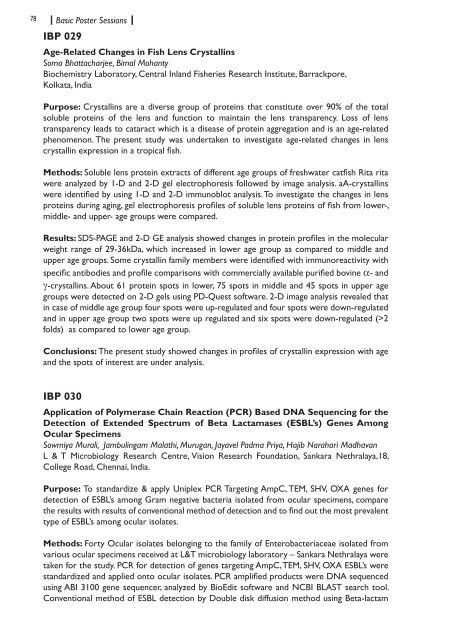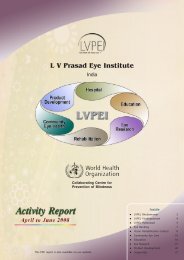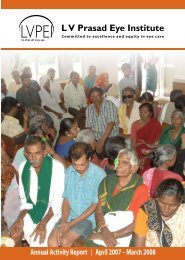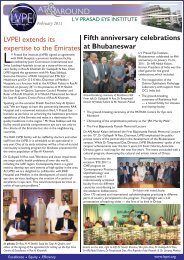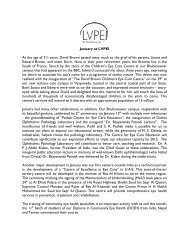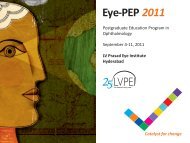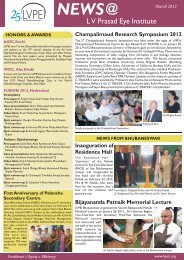IERG Abstracrt Book.indd - LV Prasad Eye Institute
IERG Abstracrt Book.indd - LV Prasad Eye Institute
IERG Abstracrt Book.indd - LV Prasad Eye Institute
You also want an ePaper? Increase the reach of your titles
YUMPU automatically turns print PDFs into web optimized ePapers that Google loves.
78 Basic Poster SessionsIBP 029Age-Related Changes in Fish Lens CrystallinsSoma Bhattacharjee, Bimal MohantyBiochemistry Laboratory, Central Inland Fisheries Research <strong>Institute</strong>, Barrackpore,Kolkata, IndiaPurpose: Crystallins are a diverse group of proteins that constitute over 90% of the totalsoluble proteins of the lens and function to maintain the lens transparency. Loss of lenstransparency leads to cataract which is a disease of protein aggregation and is an age-relatedphenomenon. The present study was undertaken to investigate age-related changes in lenscrystallin expression in a tropical fish.Methods: Soluble lens protein extracts of different age groups of freshwater catfish Rita ritawere analyzed by 1-D and 2-D gel electrophoresis followed by image analysis. aA-crystallinswere identified by using 1-D and 2-D immunoblot analysis. To investigate the changes in lensproteins during aging, gel electrophoresis profiles of soluble lens proteins of fish from lower-,middle- and upper- age groups were compared.Results: SDS-PAGE and 2-D GE analysis showed changes in protein profiles in the molecularweight range of 29-36kDa, which increased in lower age group as compared to middle andupper age groups. Some crystallin family members were identified with immunoreactivity withspecific antibodies and profile comparisons with commercially available purified bovine a- andg-crystallins. About 61 protein spots in lower, 75 spots in middle and 45 spots in upper agegroups were detected on 2-D gels using PD-Quest software. 2-D image analysis revealed thatin case of middle age group four spots were up-regulated and four spots were down-regulatedand in upper age group two spots were up regulated and six spots were down-regulated (>2folds) as compared to lower age group.Conclusions: The present study showed changes in profiles of crystallin expression with ageand the spots of interest are under analysis.IBP 030Application of Polymerase Chain Reaction (PCR) Based DNA Sequencing for theDetection of Extended Spectrum of Beta Lactamases (ESBL’s) Genes AmongOcular SpecimensSowmiya Murali, Jambulingam Malathi, Murugan, Jayavel Padma Priya, Hajib Narahari MadhavanL & T Microbiology Research Centre, Vision Research Foundation, Sankara Nethralaya,18,College Road, Chennai, India.Purpose: To standardize & apply Uniplex PCR Targeting AmpC, TEM, SHV, OXA genes fordetection of ESBL’s among Gram negative bacteria isolated from ocular specimens, comparethe results with results of conventional method of detection and to find out the most prevalenttype of ESBL’s among ocular isolates.Methods: Forty Ocular isolates belonging to the family of Enterobacteriaceae isolated fromvarious ocular specimens received at L&T microbiology laboratory – Sankara Nethralaya weretaken for the study. PCR for detection of genes targeting AmpC, TEM, SHV, OXA ESBL’s werestandardized and applied onto ocular isolates. PCR amplified products were DNA sequencedusing ABI 3100 gene sequencer, analyzed by BioEdit software and NCBI BLAST search tool.Conventional method of ESBL detection by Double disk diffusion method using Beta-lactam


